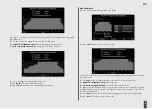
SH1
heart rate. The maximum achievable heart frequency is dependent on age. The following rule of
thumb applies here: the maximum heart frequency per minute corresponds to 220 heartbeats minus
age.
For example: at 50 years old > 220 - 50 = 170 bpm.
Weight:
a further criterion for establishing the optimal exercise data is weight.The specified value of
the maximum effort is 3 for men and 2.5 for women Watts/kg of body weight.
Furthermore, it must be considered that from the age of 30 efficiency decreases by about 1% for
men and about 0.8% for women per year.
For example: man, 50 years old, weight 75kg
>220-50 = 170 bpm maximum heart rate
>3 Watts x 75 kg = 225 Watts>Minus "age discount" (20% of 225 =45 Watts)
> 225-45 = 180 Watts (specified value for maximum effort).
Exercise intensity
Aerobic heart rate:
the optimum exercise intensity is when 65-75% (see diagram) of the individual
hear / circulation power is reached. This value changes in accordance with age.
Amount of exercise
Duration of a workout and frequency of this per week:
The optimal amount of exercise is reached when 65-75% of the individual heart / circulation
power is reached over an extended time period.
Rule of thumb:
Either 10 minutes per workout for everyday training
Or approx. 30 minutes per workout for training 2-3 x per week
Or approx. 60 minutes per workout for training 1-2 x per week.
You should choose the Watt power so that the different muscles can be trained up over an exten-
ded period of time.
Higher power (Watts) should be yielded alongside an increased pedalling frequency.
Pulsediagramm
Fitness and Fat Burner
220
200
180
160
140
120
100
80
Pulse
Age
20 25 30 35 40 45 50 55 60 65 70 75 80
Maximalpulse
(220 minus Age)
Fitnesspulse
(75% of Max.Pulse)
Fat combustion pulse
(65% of Max.Pulse)
90
A pedalling frequency that is too low, under 60 rpm, can lead to an emphasised, static stress on
the muscles and therefore to tiredness early on in the workout,
Warm-Up
You should begin each workout with 3-5 minutes of slowly increasing exercise to bring your heart
rate and circulation and your muscles up to a "trot".
Cool-Down
This is just as important as the so-called warm up. After each session (with or without recovery) you
should spend approx. 2-3 minutes pedalling in the opposite direction.
The exercise for your further endurance training should be increased to the next step, e.g. instead of
doing 10 minutes per day you should do 20, or instead of training weekly you should train 2 or 3
times per week. Alongside the individual planning of your endurance training, you can also fall back
on the exercise programmes which are integrated into the training computer.
Glossary
Age / date of birth
Should be entered in order to calculate the maximum heart rate.
B.M.I
Body Mass Index: value is dependent on body weight and height.
Computational determination of BMI:
Body weight (kg)
––––––––––––––––––
= Body-Maß-Index
Height
2
(m
2
)
Example: Thomas
Body weight 86 kg
/
Height
1,86 m
86 (kg)
–––––––––– = 24,9
1,86
²
(m
2
Standard values::
Age BMI
19-24 years old 19-24
25-34 years old 20-25
35-44 years old 21-26
45-54 years old 22-27
23
GB




























